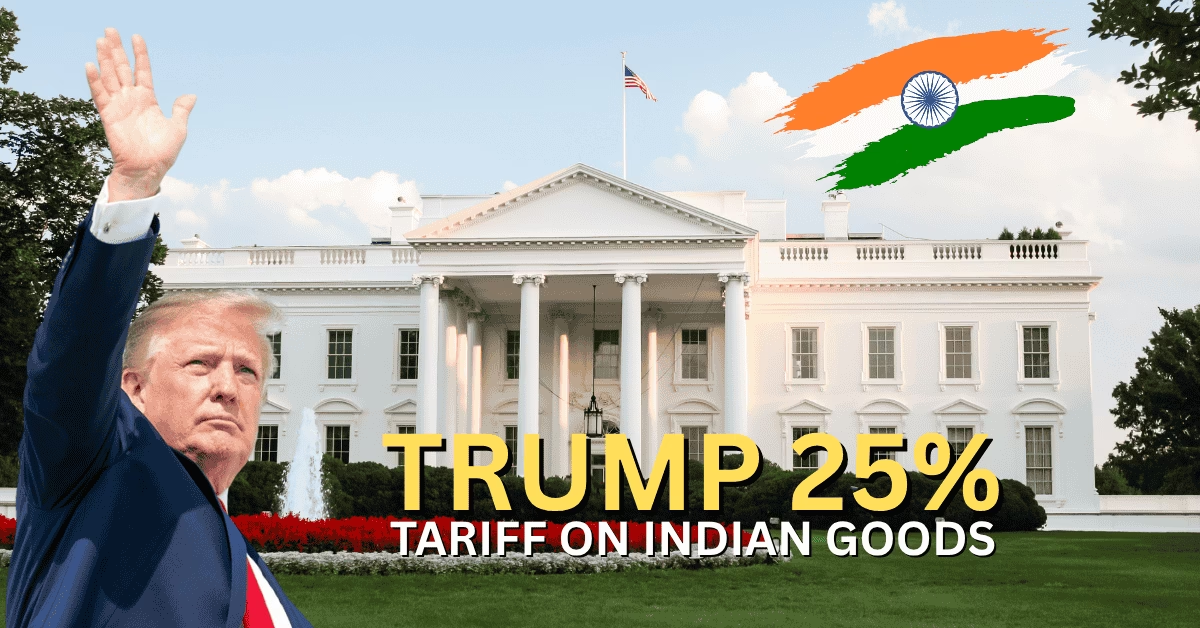Introduction: Understanding the Trump 25% Tariff on Indian Goods
On July 30, 2025, former US President Donald Trump announced a surprising move to impose a 25% tariff on Indian goods exported to the United States, effective August 1, 2025. This drastic step targets a wide range of Indian products, including smartphones, pharmaceuticals, shrimp, textiles, and more. The decision stems from ongoing trade tensions and unresolved issues between the two countries, including India’s purchase of Russian energy and military equipment.
This blog dives deep into what the Trump 25% tariff on Indian goods means for exporters, consumers, and the overall economy — in simple language that’s easy to understand.
What is the Trump 25% Tariff on Indian Goods?
A tariff is a tax imposed by a country on imported goods. The Trump 25% tariff on Indian goodsmeans that India’s exports to the US will now become 25% more expensive upon entering the American market. This tariff is expected to affect key Indian sectors, disrupting trade flows and potentially impacting everyday consumers.
Key Indian Products Impacted by the Tariff

The new tariff targets Indian products exported to the US across multiple industries:
- Smartphones and electronics: India exports smartphones and electronic gadgets worth billions to the US. With a 25% tariff, these goods will see a sharp price hike.
- Pharmaceuticals: India is a global leader in generic medicines, exporting over $12 billion worth of pharma products. The additional tariff will raise costs for American buyers.
- Shrimp: Already facing complex duties, India’s shrimp exports will now carry an even higher tariff burden, increasing competition from other shrimp-exporting nations like Ecuador.
- Textiles, gems and jewellery, auto parts, spices: These industries will also experience increased costs entering the US market.
ALSO READ : What Does the US Import from India?
Why Did Trump Impose the 25% Tariff on Indian Goods?
Several reasons influenced the decision:
- Trade imbalance: The US has a $45 billion trade deficit with India, which Trump sought to reduce.
- India’s trade barriers: Trump accused India of maintaining high tariffs and non-tariff barriers that restrict American goods.
- India’s ties with Russia: The US disapproves of India’s continued purchases of Russian energy and military equipment amid geopolitical tensions.
What Will Change Starting August 1, 2025?
Starting August 1, Indian goods entering the US will be subject to an additional 25% tax, making Indian exports significantly more expensive for American importers. For example:
- A smartphone valued at $100 (around ₹8,500) will now cost $125 (approximately ₹10,625) upon entering the US.
- Shrimp exports will bear a total tariff exceeding 34%, considering existing duties, escalating their costs further.
Impact on Indian Exporters and Economy
The tariff will likely cause several challenges for India:
- Decline in exports: Indian companies may struggle to maintain their market share in the US as tariffs make their products pricier.
- Sectoral disruption: Electronics, pharmaceuticals, shrimp, gems, and textile industries are expected to face significant pressure.
- Job losses: Export-dependent sectors may see workforce reductions due to reduced demand.
- Currency impact: The Indian rupee may weaken due to decreased foreign exchange earnings from exports.
How Will American Consumers be Affected?
American consumers could experience:
- Higher prices: The 25% tariff will increase the retail price of Indian goods like smartphones, medicines, jewellery, and clothing.
- Reduced variety: Some Indian products might become too expensive to import, limiting consumer choice.
- Supply chain adjustments: US distributors may seek alternatives from countries with favorable trade terms.
Is There a Silver Lining? What About Future Trade Talks?
The tariffs come amid ongoing negotiations for a bilateral trade deal between India and the US. While this tariff hike signals strained relations, experts hope negotiations can resume to ease trade tensions.
The Federation of Indian Export Organizations (FIEO) is urging the Indian government to push for tariff reductions and protect key sectors. Many believe that a fair trade agreement could reverse some of the negative impacts, bringing stability back to trade relations.
Summary: The Trump 25% Tariff on Indian Goods Explained
- The Trump 25% tariff on Indian goods took effect from August 1, 2025.
- It targets electronics, pharma, shrimp, textiles, gems, and more.
- The tariff aims to address trade imbalances and India’s trade policies.
- Indian exporters face higher costs and falling demand.
- US consumers will likely see pricier Indian imports.
- Ongoing talks offer hope for a future trade deal to mitigate impacts.
Final Thoughts
The Trump 25% tariff on Indian goods introduces significant challenges for India’s export-driven economy and raises costs for US consumers. It underscores the complex nature of global trade and geopolitical diplomacy.
For Indian exporters, it’s a critical moment to innovate, diversify markets, and push for stronger trade relations. For buyers and consumers on both sides, understanding these changes helps navigate the evolving economic landscape.
Stay tuned as developments unfold and trade talks continue — this tariff saga is far from over!
If you found this article helpful, please share it to spread awareness about the Trump 25% tariff on Indian goods and its wide-ranging impact.


2 thoughts on “Trump 25% Tariff on Indian Goods : What It Means for India, And the US”
Comments are closed.